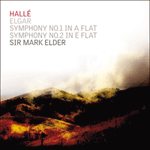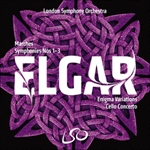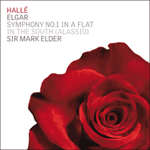
Welcome to Hyperion Records, a British classical label devoted to presenting high-quality recordings of music of all styles and from all periods from the twelfth century to the twenty-first.
Hyperion offers both CDs, and downloads in a number of formats. The site is also available in several languages.
Please use the dropdown buttons to set your preferred options, or use the checkbox to accept the defaults.

 PERFORMANCE
PERFORMANCE RECORDING
RECORDINGThe work opens with what Elgar’s wife Alice, noted in her diary as, ‘E—Playing great beautiful tune—ie the tune of the Symphony, the one which opens and closes it and influences many musical happenings along the way’. This expansive, noble melody does indeed infuse the symphony. The second movement reverses this theme while the third continues to develop it in one of the most beautiful slow movements that Elgar composed. The Finale resumes the musical argument and the struggles of the opening movement before ending in a resplendent restatement of the ‘great beautiful tune’ with which the symphony commenced, now in fully resplendent orchestral garb.
Attempts have been made to give the symphony an extra-musical programme, but Elgar himself saw none but the ‘wide experience of human life, a great charity (love) and a massive hope in the future’. Further, in a lecture given in 1905 Elgar appears to presage his own emergence as a symphonist:
Was Elgar really referring to himself? Who knows, but if so then he was certainly not far off the mark.
from notes by M Ross © 2010
Tenant une promesse qu’il avait faite en 1901, il la dédia au chef d’orchestre austro-hongrois Hans Richter, «un véritable artiste et un véritable ami». Richter, qui devint le chef du Hallé en octobre 1899, avait dirigé la création des Variations Enigma en juin 1899 et The Dream of Gerontius en octobre 1900. Il dirigea la création de la symphonie lors d’un concert du Hallé au Free Trade Hall de Manchester le 3 décembre 1908. À cause d’un épais brouillard, la salle était loin d’être pleine, mais l’enthousiasme du public fut retentissant. Les auditeurs applaudirent si fort à la fin du mouvement lent que Richter fit monter Elgar sur le podium. À Londres quatre jours plus tard, lorsque Richter dirigea la symphonie avec l’Orchestre symphonique de Londres, l’accueil fut encore plus démonstratif. A.J. Jaeger, le «Nemrod» des Variations, déclara à Elgar que le mouvement lent était digne de Beethoven, tandis que Richter qualifiait l’ouvrage de «plus belle symphonie des temps modernes». Il la reprit au Hallé le 4 mars 1909 et une fois encore en octobre suivant. Pendant sa première année d’existence, elle fut interprétée quatre-vingt-deux fois dans le monde, dont dix-huit à Londres. Lors du concert de centenaire du Hallé le 30 janvier 1958, c’est cette symphonie qui fut choisie par Sir John Barbirolli comme clou de la soirée.
Certains ont tenté de donner à cet ouvrage un programme extra-musical, mais Elgar disait qu’il n’en avait aucun «au-delà d’une vaste expérience de la vie humaine, d’une grande charité (l’amour) et d’un immense espoir en l’avenir». On peut le dire aujourd’hui, cette symphonie constituait une tentative d’Elgar pour réconcilier les éléments contradictoires de sa propre nature. Il déclara à un ami qu’il s’agissait «d’un réflexe, d’une image ou d’une élucidation» de sa vie et confia à un autre: «Cette musique, c’est vraiment moi, tout seul».
Un roulement de tambour introduit le thème de marche en la bémol qui va hanter toute la symphonie. Il est joué calmement et dolce au départ, puis il devient plus plein, plus fort. Il se fond dans une section Allegro en ré mineur, démarrant avec agitation mais devenant ensuite plus tendre tandis que trois nouveaux thèmes forment le groupe du second sujet. Les efforts du thème signature pour réaffirmer sa domination sont farouchement repoussés, mais il reparaît aux violons et aux altos et submerge peu à peu tout l’orchestre. Le thème principal précipité du deuxième mouvement (en fa dièse mineur) est l’inversion du thème signature. Il est brillamment orchestré, tout comme la section centrale envoûtante qu’Elgar recommandait aux orchestres de jouer «comme quelque chose que vous entendez au bord d’un fleuve». Le mouvement se ralentit et glisse presque imperceptiblement vers le ré majeur extatique de l’Adagio. Ce thème est note pour note celui du thème principal du deuxième mouvement, mais la transformation est totale. La sérénité et l’apaisement de la musique nous ouvrent le cœur d’Elgar et ne nécessitent aucune analyse.
Le finale renoue avec les hostilités du premier mouvement. Il commence subrepticement, presque menaçant, son thème de marche suivi par les volutes des vents dessinant des fragments du thème signature. Mais cette atmosphère est dissipée et le thème principal hésitant est développé en une mélodie magnifique, confiée aux cordes. Finalement, le thème signature reparaît dans une orchestration scintillante, mais sa victoire finale est durement acquise, comme le soulignent les efforts faits pour perturber son rythme par des syncopes fortement accentuées.
extrait des notes rédigées par Michael Kennedy © 2008
Français: David Ylla-Somers
Um ein Versprechen zu erfüllen, das er 1901 gegeben hatte, widmete Elgar sie dem aus österreichisch-ungarischen Landen stammenden Hans Richter, den er als “wahren Künstler und wahren Freund” bezeichnete. Richter, der im Oktober 1899 Dirigent des Hallé Orchestra wurde, hatte im Juni 1899 die Uraufführung der Enigma Variations und im Oktober 1900 The Dream of Gerontius geleitet. Er dirigierte die Uraufführung der Sinfonie am 3. Dezember 1908 anlässlich eines Hallé-Konzerts in der Free Trade Hall in Manchester. Obwohl der Saal wegen dichten Nebels keineswegs voll wurde, war der Enthusiasmus des Publikums ungeheuer. Es klatschte am Ende des langsamen Satzes so erregt, dass Richter Elgar aufs Podium winkte. Vier Tage später in London war die Begeisterung noch unverhohlener, als Richter die Sinfonie mit dem London Symphony Orchestra aufführte. A.J. Jaeger, der “Nimrod” der Enigma Variations, versicherte Elgar, dass der langsame Satz eines Beethoven würdig sei, und Richter bezeichnete das Werk als “die bedeutendste Sinfonie der Moderne”. Er wiederholte die Aufführung mit dem Hallé am 4. März 1909 und noch einmal im darauf folgenden Oktober. Im ersten Jahr ihres Daseins wurde die Sinfonie rund um die Welt zweiundachtzigmal aufgeführt, davon allein achtzehnmal in London. Beim Konzert zur Hundertjahrfeier des Hallé am 30. Januar 1958 wählte Sir John Barbirolli die Sinfonie als Höhepunkt des Abends.
Es wurden Versuche unternommen, dem Werk ein außermusikalisches Programm zu verpassen, doch Elgar sagte dazu, es habe “über ein breites Erlebnisspektrum des menschlichen Lebens, große Güte (Liebe) und massive Hoffnung auf die Zukunft” keines zu bieten. Es war, wie wir aus heutiger Sicht feststellen können, Elgars Versuch, die gegensätzlichen Elemente seines eigenen Wesens auszusöhnen. Einem Freund teilte er mit, es sei “ein Reflex, ein Bild bzw. eine Erläuterung” seines Lebens, und einem anderen vertraute er an: “Ich bin wirklich der Einzige in dieser Musik.”
Ein Trommelwirbel leitet das Marschthema in As-Dur ein, das durch die ganze Sinfonie geistern wird. Es wird zunächst ruhig und dolce gespielt, dann voller besetzt und lauter. Es klingt aus in eine Allegro-Passage in d-Moll, die rastlos anfängt, jedoch später eine sanftere Atmosphäre annimmt, wenn drei neue Themen die Seitenthemengruppe bilden. Die Bemühungen des Mottothemas, sich wieder durchzusetzen, werden erbittert bekämpft, doch es taucht erneut in den Geigen und Bratschen auf und überschwemmt allmählich das ganze Orchester. Das geschäftige Hauptthema des zweiten Satzes (in fis-Moll) ist die Umkehrung des Mottothemas. Es ist brillant orchestriert, genau wie der betörende Mittelteil, der laut Elgars Anweisung ans Orchester gespielt werden soll “wie etwas, das man drunten am Fluss hört”. Der Satz verlangsamt sich und geht beinahe unmerklich ins verzückte D-Dur des Adagio über. Das zugehörige Thema entspricht Ton für Ton dem des Hauptthemas aus dem zweiten Satz, doch die Verwandlung ist total. Die stille Heiterkeit und Tröstlichkeit der Musik, die im Herzen von Elgars Schaffen liegen, bedürfen keiner Analyse.
Das Finale nimmt das Ringen des ersten Satzes wieder auf. Es beginnt verstohlen und regelrecht bedrohlich und lässt auf sein Marschthema Fetzen des Mottothemas folgen, die in den Holzbläsern aufwirbeln. Dann jedoch ändert sich die Stimmung, und das zaudernde Hauptthema wird zu einer herrlichen Streichermelodie erweitert. Schließlich kehrt das Mottothema in funkelnder Orchestrierung zurück, aber sein endgültiger Sieg ist schwer erkämpft, was die Anstrengungen unterstreichen, seinen Rhythmus durch stark akzentuierte Synkopierung zu stören.
aus dem Begleittext von Michael Kennedy © 2008
Deutsch: Anne Steeb/Bernd Müller
 Elgar: Symphonies Nos 1 & 2 Elgar: Symphonies Nos 1 & 2Over a century after they gave Elgar's Symphony No 1 its first ever performance, the Hallé returns to this most favourite of works, the new recordings here presenting both symphonies plus a lush new orchestral arrangement by Colin Matthews of Elga ...» More |
 Elgar: Symphonies, Marches, Enigma Variations & Cello Concerto Elgar: Symphonies, Marches, Enigma Variations & Cello ConcertoOver five hours of sumptuous orchestral grandeur in a bargain new set of classic Elgar recordings from the London Symphony Orchestra.» More |
 Elgar: Symphony No 1 & In the South Elgar: Symphony No 1 & In the South‘No doubt about the highlight here: 'In the South' receives a performance of exhilarating swagger and sighing poignancy’ (Gramophone) ‘This Elgar 1 is good, but In the South is even better! There’s a magnificent sweep to this performance and Elder gets to grips with the music from th ...» More |

